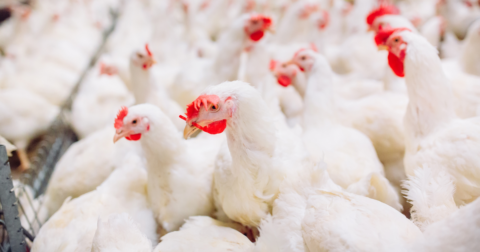News
Costco Chicken Processing Plant Keeps Failing Tests for Salmonella
Food•5 min read
Explainer
Why eating chicken is not necessarily more ethical than eating beef.


Words by Björn Ólafsson
Most people don’t know that over a million chickens are killed every hour in the United States. Due to the growing popularity of their meat, chickens have been selectively bred for decades to grow faster and fatter than ever before, leading to significant animal welfare problems. And, because they are still small animals compared to cows and pigs, they are killed in numbers far beyond any other farmed land animal. Most of the billions of chickens alive in the world at any given time will only live a few weeks before being slaughtered.
The massive number of chickens being killed — 20 million chickens per day globally — can make it difficult to think of chickens as individuals. Yet, despite stereotypes, chickens are highly communicative and enjoy playing with each other to pass the time. Unfortunately, they rarely get those opportunities in factory farming.
Here are some statistics about the global chicken industry every consumer should know.
According to data from FAO, at any point in time there exists about 27.61 billion chickens in production. Since industrially bred chickens rarely live longer than a few months, the number of chickens born and killed every year is far higher: 73.79 billion.
These chickens are consumed in numbers that are unfathomable to comprehend — nearly 140 million tonnes of meat worldwide, the weight of 383 Empire State buildings.
Globally, just under 74 billion chickens are killed annually for human consumption; a number that rises every year.
There are 27.6 billion chickens alive at any given moment, but only around 8 billion humans, as of 2022. This means chickens outnumber us by a ratio of about 3.5 to 1.
Pet chickens, sometimes called backyard chickens, are not uncommon in the United States. However, the phrase “pet chicken” can be misleading — for many backyard chicken enthusiasts, chickens are killed when they are no longer producing sufficient eggs. While exact numbers of the chickens themselves aren’t tracked, an estimated 10 million Americans keep backyard chickens.
The U.S. chicken industry breeds and slaughters about 9.5 billion chickens every single year. That’s about 26 million birds killed every single day — a little over a million chickens an hour.
Chicken consumption skyrocketed in the U.S. in the twentieth century, finally surpassing cows as the most-consumed animal in 2010. Chicken is often cheaper and more versatile than beef, leading many consumers to eat it several times per week, creating the massive poultry industry that exists today.
But chickens are smaller animals, which means that every switch from beef to chicken results in more animals being killed for each meal. America’s appetite for chicken is why the number of animals being killed in the U.S. has increased more than ever before.
As of 2022, there were over 168,000 poultry farms in the United States, a number that is increasing over time. The majority of chickens are raised in massive facilities, often crammed together with many other birds, with little space to move around. Seventy-five percent of laying hens, for example, are raised in farms with more than 100,000 other birds.
The chicken meat industry is highly concentrated, meaning just a handful of companies can control the entire market. This is called an oligopoly, when a few companies are able to exert control over the entire industry. In fact, many of the chicken brands you may see in stores are actually subsidiaries of larger companies, like how Hillshire Farms is part of chicken behemoth Tyson.
As of a 2020 paper, four companies — Tyson, Pilgrim’s Pride, Sanderson Farms and Mountaire Farms — control over half of the market, while small companies only have about 20 percent total.
The U.S. produces enough eggs for each consumer to purchase around 279 eggs per year, after accounting for trade and storage. Unlike demand for chicken meat, however, egg consumption has been declining for several years now.
Meanwhile, the average person in the United States eats 69.3 pounds of boneless chicken per year, not excluding food waste on the consumer level.
There are likely hundreds of breeds of chickens worldwide. A breed is essentially a species subcategory in which specific traits like color, size, plumage and more are consistently passed down genetically. The American Poultry Association names nearly 100 recognized breeds, while the British Poultry Association lists 109.
Yes, wild chickens can be generally grouped into two types: junglefowl and feral chickens. The first are the ancestors of modern day chickens and still exist, primarily in South East Asia, although the exact number is unknown.
Feral chickens, on the other hand, are escaped or released domesticated chickens and their descendants — a unique evolutionary journey to say the least. Again, exact numbers aren’t known, but these interesting animals are most associated with Hawai’i, where they are quite common.
Many people, sometimes urged by climate activists, are considering replacing beef with chicken in order to eat more sustainably. It’s true that chicken production creates a far smaller carbon footprint than beef or pork. But the chicken industry is still highly inefficient, contributing to water and air pollution, and fueling deforestation in South America. Plant-based versions of chicken are still proven to be far more sustainable than any form of meat.
From a welfare perspective, replacing larger animals like cows and pigs with chickens is actually more harmful, since it means a greater number of animals are killed. Despite claims from the meat industry, most chickens live horrific lives and often are killed in painful ways. Reducing chicken intake is also one of the most efficient ways to reduce one’s individual impact on animal lives.
When considering your impact on the environment and on animals, chicken consumption presents a tricky conundrum: should you prioritize smaller animals with comparatively smaller environmental footprints, but more animal welfare concerns, like chickens? Or is it more ethical to eat fewer, larger animals who have higher carbon hoofprints?
Instead of substituting certain types of meat for each other, many climate-conscious people are choosing to reduce their overall meat intake, sometimes going vegetarian or vegan.